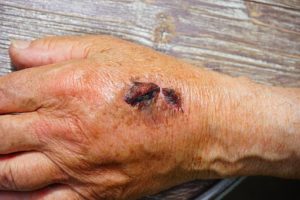Could this be good news for hemophilia B patients? Preliminary research shows that one dose of gene therapy can help hemophilia B patients. As described by the National Hemophilia Foundation, this is a hereditary disorder where a person lacks the protein required for blood clotting. It is also known as Christmas disease. Lack of a protein known as factor IX or productive of defective of the same is what results to hemophilia B. A hemophiliac person has a moderate or severe bleeding with a clotting factor level below or equal to 2% of levels in a healthy person.
Blood clotting
 Normally, bleeding stops as a result of the coagulation cascade. Blood platelets gather together on the wound site, and then blood clotting factors work together to form a more permanent plug in the wounded area. Therefore, if one has a low amount of factor IX, clotting will not occur immediately, and so bleeding takes long to stop.
Normally, bleeding stops as a result of the coagulation cascade. Blood platelets gather together on the wound site, and then blood clotting factors work together to form a more permanent plug in the wounded area. Therefore, if one has a low amount of factor IX, clotting will not occur immediately, and so bleeding takes long to stop.
According to the Foundation, Hemophilia B occurs once in every 5000 births. It can lead to excessive bleeding. People with the condition bleed very easily, and their blood takes long to clot. They are prone to experiencing spontaneous internal bleeding and painful swollen joint as a result of bleeding in the joints. This spontaneous bleeding may result to blood in stool and urine, deep bruises, bleeding gum, tight and painful joints, frequent nosebleeds and irritability in children. Symptoms that may constitute a medical emergency are such as vomiting repeatedly, severe headache, double or blurred vision, neck pain, extreme sleepiness and continuous bleeding from an injury.
Gene therapy
With this new trial of gene therapy, researchers reported that there is no medical treatment which has ever boosted factor IX level to the same amount as gene therapy. According to the study, patients who had the gene therapy done on them were able to say goodbye to infusions of the clotting factor.
 The goal of the research was to increase gene therapy product safety and determine whether they could reach certain amounts of factor IX that could lower bleeding events. The objective is to edit a defective gene to attain a complete reversion of a disease phenotype for the lifetime of a patient. In the current treatment, in a week a patient gets a couple of intravenous doses of factor IX, and still, these levels fluctuate. According to the research, with one dose of gene therapy patients’ factor IX levels went up to around 30, which is almost normal! With these new levels, patients do not necessarily require to self-treat with factor IX to prevent bleeding events. This translates to a potential improvement in the quality of life plus a change in the way they view hemophilia treatment.…
The goal of the research was to increase gene therapy product safety and determine whether they could reach certain amounts of factor IX that could lower bleeding events. The objective is to edit a defective gene to attain a complete reversion of a disease phenotype for the lifetime of a patient. In the current treatment, in a week a patient gets a couple of intravenous doses of factor IX, and still, these levels fluctuate. According to the research, with one dose of gene therapy patients’ factor IX levels went up to around 30, which is almost normal! With these new levels, patients do not necessarily require to self-treat with factor IX to prevent bleeding events. This translates to a potential improvement in the quality of life plus a change in the way they view hemophilia treatment.…

